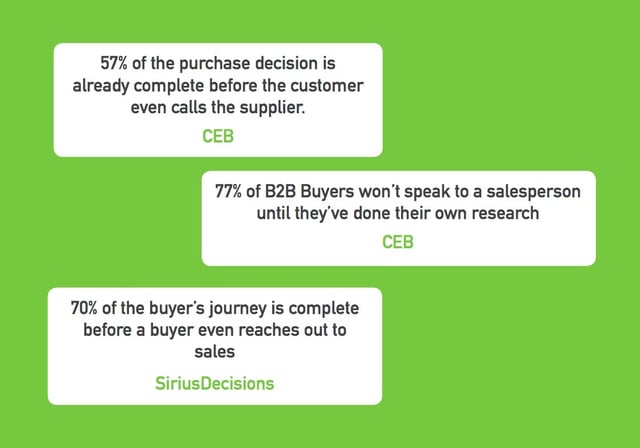Get WISER with Your AI Prompts - A guide for sales managers
Everyone’s wittering on about AI like it’s the second coming. But here’s the rub: if you give it half-baked prompts, you’ll get half-baked answers....
4 min read
 Chris Fell
06/09/2016 1:56:43 PM
Chris Fell
06/09/2016 1:56:43 PM

Stop thinking of your website as your online brochure. It should sit at the heart of your lead generation efforts and be the engine room of your marketing and sales funnel, becoming the cornerstone of your market presence.
It really is that important.
Why? Because so much of today's B2B buyer's journey is self driven, researched online and done at a time and at a pace of their choosing.

Trying to catch your buyer at just the right moment in their decision making cycle to receive a cold call or a cold email from you, is a lottery. Cold calling and emailing success rates are tumbling. It is time for Australian businesses to grasp this fundamental truth and redesign their approach to lead generation.
This article argues you should start with your website. Here's why:
Lead generation success means being present across multiple channels because you just don't always know which channel your buyer is using to do their purchasing research. Are they using Google search to find interesting articles? Are they clicking on paid ads? Are they asking their peers on LinkedIn for a recommendation or visiting your site directly after a recommendation from a friend over a cup of coffee? Perhaps they have received a newsletter from you and see you as a trusted source, after all they have been following for a while now and are hooked on the interesting, compelling, thought leadership you write!
Regardless of which channel your buyer is using to do their research, all paths should lead to your website. But not just anywhere on your site, you should carefully establish specific points of conversion (POCs) - usually landing pages or Calls-To-Action (CTAs) placed on high traffic site pages or a specific blog article that is unique to that channel. That way it is easy to track which channel is the best source of traffic and crucially, how succesful is that channel at converting a visitor to a contact (ie they have given you their contact information through a form). This is so important as, over time, you are able to see which channels yield the best return on effort and money spent and you can invest more heavily in optimising the best channels further.
One important point of note is that you will have visitors coming to your site from multiple different devices. A large number of them wil be mobiles and tablets so its critical that your site is responsive and adapts its design to the end users viewing device. its also deemed highly important by Google so much so that they are starting to penalise sites that are not responsive.

The next question to ask yourself is why would a visitor chose to give you their contact information in the first place? Your website must be a location of genuinely valuable content for your target buyer (note the use of the word "genuinely"!). Too many times websites are packed to the gills with thinly disgusied self serving sales pitches. This is NOT what your flighty, easily distracted, visitor wants to consume. Instead your content must attract them like a magnet, engage and compel them. Honestly, it's a tall order in these days of content overload and it requires careful planning and a deep understanding of your buyers pain points and aspirations. Careful, detailed research with your chosen targets (your different buyer personas) should be undertaken to understand not just their demographics, but also their behaviour. Their behaviour is driven by their current list of challenges with which they are dealing with that's preventing them reaching their goals. Understand this first and developing compelling content becomes a great deal easier.
After a buyer's initial questions are answered, they are better able to define what it is they might need to solve their problems. Now they'll want to discover more about how you can help them. Use your site to pull them deeper into their decision journey. Content that helps them understand their needs is now welcomed by the buyer. Good websites have content such as calculators, case studies and video demonstrations to help the buyer work out what they need. At this point the buyer is still in self service mode, they don't want to speak with a salesperson yet, but your website continues to assist them on their journey and you are able to exert influence over them by providing content that is closely aligned to their needs.
Once again tracking a user's behaviour on your site is crucial. By "scoring" a lead's behaviour you are able to determine when a lead is qualified and ready to be persued by sales. Because the website has been tracking the buyer's behaviour it is able to deliver a rich stream of information to the sales person about their online behaviour and the information they have given you on the forms they have completed. This is the principle reason for the significantly higher close rates of leads generated from this type inbound lead generation.
Hopefully this blog has shed some light on how to use your website for lead generation. You must have a site that:
But how should you get your website fit for the purpose for lead generation? There is a new approach to web design that is rapidly emerging as the right way to redesign and build websites. Its called Growth Driven Design and draws from the agile software development movement. We have used this approach successfully with our own site redesign and now use it for all our site (re)designs for clients. Here is a short case study you might find useful. Also we'd encourage you to check out this short ebook on the topic. In summary it argues that you should develop a site fast and with your target buyer firmly in mind. This is your launch site. Then run content campaigns across multiple channels and carefully track what and is not working using the data to actively change and improve the sites design and flow based on real visitor and customer data.
To read more about this new website design concept, please click on the CTA below:
Subscribe to our latest news and updates on HubSpot.

Everyone’s wittering on about AI like it’s the second coming. But here’s the rub: if you give it half-baked prompts, you’ll get half-baked answers....

The business world is falling head over heels for AI—and who can blame it? With promises to reduce grunt work, uncover insights, and turbocharge...

Search is evolving - fast. For two decades, SEO has revolved around Google’s algorithm: keywords, backlinks, metadata, and page speed. But with the...